2023 and Beyond: A Visionary Q&A with FreeWave
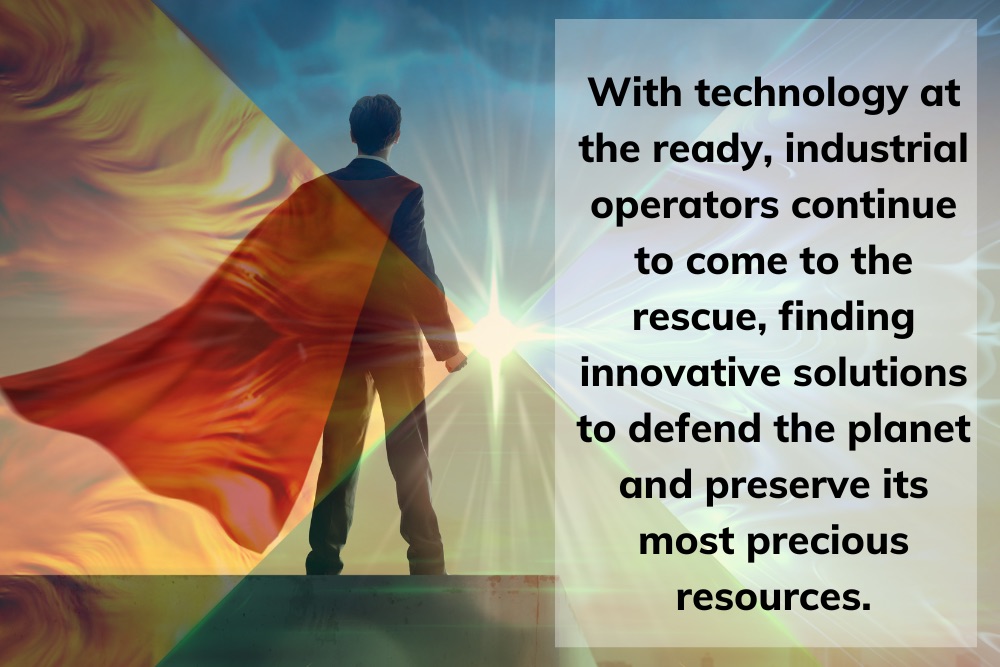
With fresh insight and excitement for the year ahead, the FreeWave leadership team discusses their vision for the future, predictions about the evolution of data, and collective approach to protecting life’s essentials. Though you might not find their names in the next Marvel film or DC comic book, industrial leaders – whether in agriculture, energy, utilities, or another resource industry – are the heroes of the modern world, real-life Guardians of the Galaxy, if you will. These heroes fight today’s challenges every day, while life’s essentials like food, air, energy, and water are threatened daily. With technology at the ready, industrial operators continue to come to the rescue, finding innovative solutions to defend the planet and preserve its most precious resources. At FreeWave, our goal is to continually build upon technology advancements to help you build a better world within your industry. With 2023 right around the corner, we asked four of FreeWave’s senior leaders, including Kirk Byles (CEO), Michael Tate (COO), Parthesh Shastri (CTO), and Jeff Horton (CRO) to share their thoughts on how FreeWave Technologies is helping the heroes of today protect life’s essentials to create a better tomorrow. ___________________________________________________________________ Q: What is one of your favorite FreeWave memories from this past year? Kirk Byles: It’s hard to even remember before this quarter, but the Reinke Dealer Conference was definitely a top highlight for me this year. Not only did it show the work our collective teams have been doing to build relationships and finalize a new product offering, but it was also really cool to see the impact our work is having in real-time, as we partner with Reinke – one of the largest pivot irrigation manufacturers in the world – to help growers and producers save water and raise crops. This was really big. Parthesh Shastri: This year, we really came together across disciplines within FreeWave, too, increasing our focus on target outcomes to deliver products that our customers use and deploy in the field, and we had a lot of fun while doing it! As we look at 2023, we are excited to scale this model and implement it across new industries. Q: How is FreeWave helping industrial operators protect life’s essentials? Jeff Horton: The top thing that comes to my mind is bringing automation to irrigation. We work closely with our partners, like Reinke, to provide real-time analytics, which saves a lot of water and nutrients, and both of these things are invaluable for farmers. Technology also helps to reduce fuel consumption on ranches by eliminating the need to manually check cattle watering tanks. Some producers often spend 12 to 15 hours a week driving around just to look at their water tanks. Think about the wear and tear on those pickup trucks or even the rising cost of fuel. Being able to reduce greenhouse gas and save these guys money while also producing a high return on investment is a really big deal. We can do that easily with the Tank Level Monitor. Mike Tate: And it’s not just the ROI. These producers are suffering. Ranching is not the lucrative business that it once was, and these ranchers are getting beaten at every turn. A lactating cow needs one gallon of water for every hundred pounds, every six hours! Water is a huge concern for both producers and growers, and being able to give them back more time while reducing their expenses is a great value add because every dollar counts for them. Q: Is the word “efficiency” changing for industrial operators? Jeff: When you look at conditions today, both here in the United States and globally, you see so many labor shortages, droughts, inflation, and climate changes, and it’s forcing efficiency, not for efficiency’s sake, but for sustainability and survivability. Businesses have to fundamentally change the way they produce a product, and they have to find the least expensive, most efficient path to go to market. Efficiency isn’t an option anymore; it’s a necessity. Kirk: For years, everybody has wanted to do more with less, and usually, there’s some sort of limitation in the way until someone invents a solution that takes things to the next level. That’s what we’re all about at FreeWave. We’re not doing anything necessarily earth-shattering; but we are innovating. We’re providing a mechanism for our customers to become more and more operationally efficient – to increase their bottom line – and make things better, and not just for their business, but for their employees and life, in general. Case in point: oil and gas companies, considered by some to be big polluters. However, these companies have many sustainability and environmental initiatives and tenants they strive to uphold. They are a critical component of our everyday lives. They’re evolving and innovating, too. FreeWave, helps them get the most out of the equipment they have on-site so that they’re more effectively getting the oil and gas out of the ground with minimal impact. Overall, a more efficient company means less impact on the environment, and these kinds of solutions help create a better planet. Q: In your wildest imagination, where can technology take the industrial leader in the next ten years? Parthesh: There are so many great examples. In China, there’s currently a 12-story tall facility being built to raise hogs in a conditioned environment. It’s like an office space for swine. In this environment, technology is being used in such a way that human intervention is really minimized, and because most things are entirely data-driven, they are able to be a lot more efficient. Now, there are pros and cons to what’s taking place there, and we won’t know the final outcomes for a while, but the march of technology is going to continue to go on, and I believe we will continue to see a lot more practices like this in the future. Jeff: Another example is indoor growing facilities in Saudi Arabia and Qatar. Massive facilities that are purpose-built for farming simply because there is
Ranch Life: Water Visibility is Critical Part 2
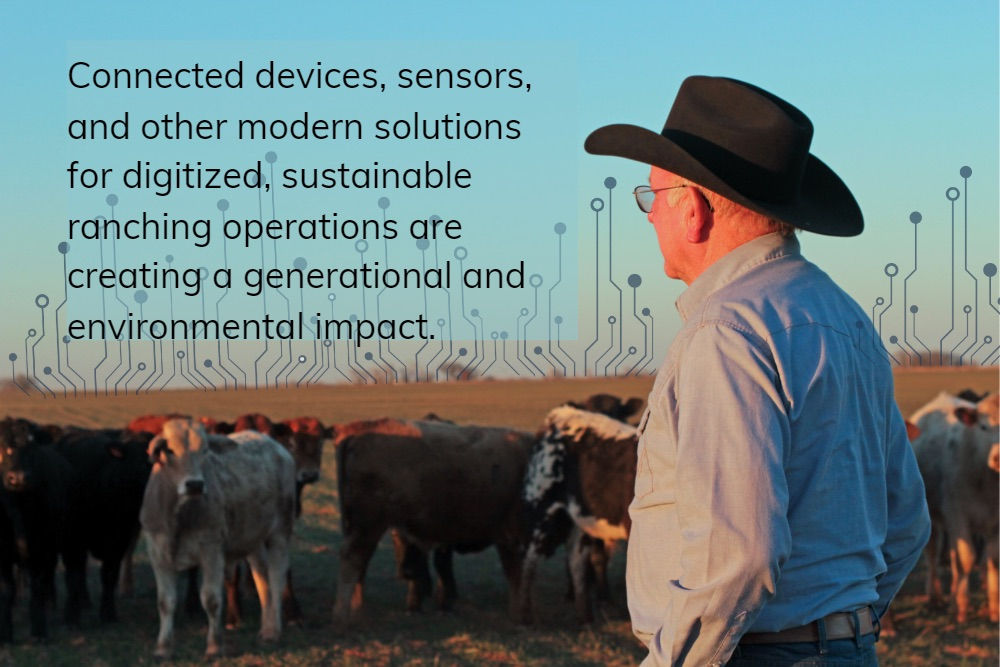
Measurement is part of a farmer’s DNA. It improves plant yields, herd health, resource conservation and impacts the bottom line – from ensuring livestock reach their peak for maximum prices at auction to guarding against overgrazed pastures. Observation and measurement, especially for the stewards of our land, determines performance in many categories of a ranch’s operations. In Part 1 of this series, we explored how the metrics of today and those of the original homesteaders varies in one significant way: technology. A quick recap: The Internet of Things (of the ranch) or IoT is like having an extra set of “eyes and ears” spread across the ranch. In short, connected devices are bringing near real-time visibility into what is happening in disparate parts of the ranch. How do all those devices spread across thousands of acres bring value? Here are five scenarios modern ranchers are using to transform their operations. Scenario One: Instead of rolling out trucks to check water usage in stock tanks, ranchers are saving time using alerts or checking tank levels on their devices Tank level and creek/river monitoring solutions (FreeWave Water Level Monitor) help ranchers manage water usage better. In the past, and to some effect still today, farmers and ranchers don’t know how much water they use. Inexpensive and simple-to-deploy sensors in tanks, aquifers, springs, and pumps allow ranchers to know exactly what is happening with water usage and make intelligent decisions about watering pastureland and hayfields, filling tanks, and moving water. (click here for a special price offer for a limited time) Ranchers are in the “driver’s seat” (without ever leaving their chair) by setting parameters – thresholds like water levels or flow. Technology can seem complicated to many of us sometimes, but the IoT devices we are talking about are not. Drop-in remote sensors simply plug in so ranchers can see what’s happening, in near real-time, rather than driving across thousands of acres in a gator to check hundreds of troughs and water supplies. Ranchers can easily monitor water levels in tanks 24/7 without routine in-person maintenance checks. (Bonus: there are no set-up fees with our solution.) Scenario Two: Paperwork is easier and faster using real data. Less manual inspections mean safer working conditions and less vehicle costs A digital ranch goes beyond automatic water distribution; it also includes insight and access to data metrics to help monitor and stay within local water use regulations. Ranching operations require lots of paperwork, especially those using public lands for grazing. For irrigation systems that take water from a natural resource such as an on-farm stream or river, data helps ranchers measure water availability and flow. By rolling out fewer trucks to check on stock tanks, there’s less wear and tear on trucks and less man-hours dedicated to manual inspections. Scenario Three: Soil moisture level monitoring improves grazing health Not only can digital solutions enhance the quality of water production on a ranch, but they can also play a role in helping to visualize and maintain the quality of the soil for high quality grass for grazing. Sensors determine soil moisture levels and overall health from the air. Better soil means a better ranch, and a better ranch means healthier land, livestock, and profitability. With near real-time data in hand, ranchers can make more informed decisions – just like they always have through observation and measurement – about soil behavior. For example, knowing actual soil moisture levels influence when to rotate cattle on different fields so ranchers can fertilize the land, continually giving fresh grass for the cattle to munch on. Scenario Four: Preparing for adverse weather A string of hot days, the possibility of wildfires, and water scarcity along the Great Plains changes the game for ranchers. No one can control the weather, but technology can help ranchers prepare. Virtual visibility into the surrounding climate of a ranch utilizes timely data to prepare and respond to natural weather updates and climate changes like wildfires, wind erosion, or soil erosion that might threaten ranchland management. Good decision-making and preparedness reduce energy costs and environmental impact. Scenario Five: Carbon dioxide detection is no longer a guessing game Last, but certainly not least, carbon dioxide detection is a game-changing tool for today’s rancher. With the right sensors in place, you can both manage your carbon dioxide emissions and monitor your CO2 levels to ensure better, more drought-resistant soil, which will ultimately aid in the sustainability of water conservation practices. With technology being the “ears and eyes” of the rancher, less money is spent on diesel and, as previously mentioned, wear and tear on trucks rolling out to different sites. The Road to Lean and Mean For those tending vast, open, and oftentimes remote expanses of land, FreeWave’s simple-to-use solutions are turnkey. These modern solutions for digitalized, sustainable ranching operations are creating a generational and environmental impact. They are up and running within 10 minutes or so. Using just about any device – cell phone, tablet, laptop, or desktop computer – ranchers see a dashboard, or what we like to call a single pane of glass. It sounds almost crazy, but FreeWave technology can work in virtually any environment, no matter how remote. Like many customers we serve, we put in our time to hone our craft: we started 30 years ago as a U.S. manufacturer of mission-critical wireless data radios operating in the harshest and most dangerous places for the military. FreeWave has created low-cost ranch coverage solutions to monitor stock tanks, water troughs, rivers, dams and other water supplies in areas with limited or no cell coverage using a variety of solutions, including satellite, cellular, Wi-Fi, Bluetooth, and more. Contact us to learn how you can get valuable time and money back from your ranch operations.
Ranch Life: Water Visibility is Critical Part 1
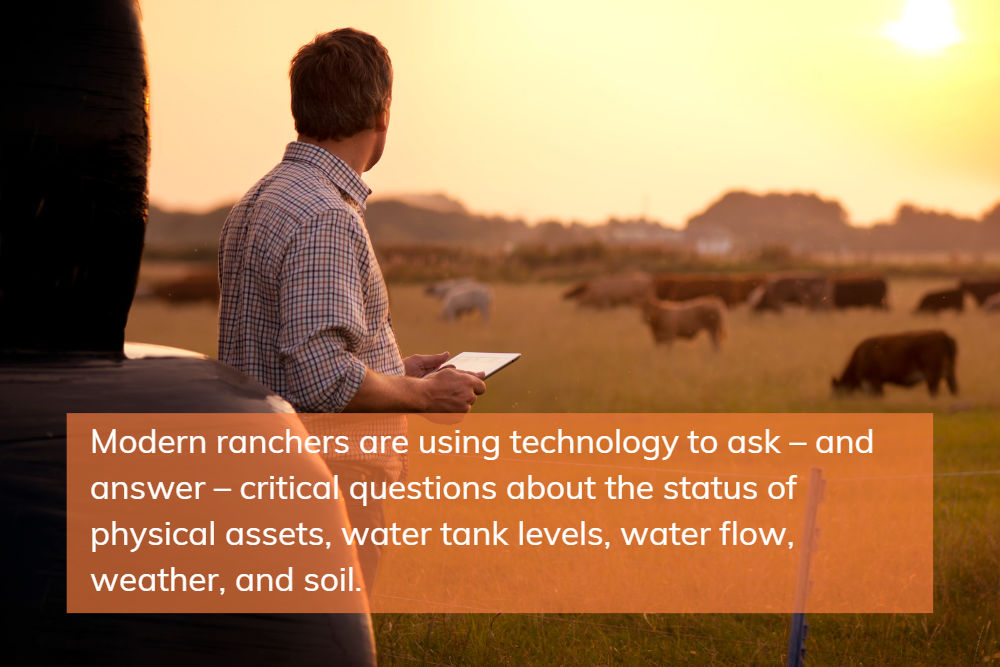
There is no average day in the life of a rancher. Many kickstart their morning at 4 a.m., when most people are still fast asleep. After breakfast, the real work and the long day begins. It might include mending fences, checking grass levels across thousands of acres, rotating cattle or even being called unexpectedly to tend to a neighbor’s sick animal. All this is done by riding the land or rolling out trucks in hard-to-reach places with little or no cell coverage – and so much connects back to water. From land and hay operations to logging and livestock operations, water conservation touches almost every aspect of ranch performance and profitability. Take JJ Goicoechea, for example, who travels at least 40 miles a day (one way) to check on the viability of the water on his land for the surrounding cattle and wildlife. Or Bob Skinner, who used his own funds to purchase an airplane as a means to check on his pipelines every 48 hours. These examples, courtesy of the Public Lands Council, show observation and measurement for better on-ranch performance is nothing new for ranchers. What has evolved is how the modern rancher observes and measures today with near real-time visibility, particularly when it comes to water management. Water Becomes a Commodity It’s no secret that water is a rancher’s most valuable asset. Safe, clean, abundant water sources are necessary for the health of the herd. Water impacts the profitability of ranch operations, many of which were handed down from previous generations. There’s a new challenge, though, that the men and women who homesteaded the land did not have to contend with: extreme weather and unreliability of water sources. Case in point: 2012, when two-thirds of the lower 48 states were in a drought. Or earlier in 2022, when according to the U.S. Drought Monitor, more than 32% of western states, including Texas, Utah, Oregon, and New Mexico, were in a severe drought – the worst megadrought reported in 1,200 years, according to Scientific American. With the unpredictability of nature and the need to conserve reliable, clean sources of water, a better, more efficient way to store and sustainably save water is surely needed. What if You Could See the Entire Ranch on Your Device? Just like their forefathers, a rancher’s keen eye for observation and measurement serves them well. There’s a gut check to making decisions, and experience guides the way. That will never change. The modern cowboy, however, is evolving in one significant way: they can now see their entire ranch operation in real-time on a connected device: cell phone, tablet, laptop or desktop computer. Here is how near real-time visibility – being able to see the different parts of a ranch without physically being there – works. Sensor technology “carries the water” for ranchers and farmers, helping them visualize what’s happening across thousands of acres without having to physically roll out trucks. These devices, or “things,” then relay data back to ranchers so they can make informed decisions based on near real-time visibility. It’s like having extra “eyes and ears” spread across the ranch. In short, these connected devices are the Internet of Things (of the ranch) or IoT, for short. FreeWave provides a drop-in solution – our Tank Level Monitor – that’s easy to install, set-up, and manage. For any of us, you don’t know what you don’t know. For ranchers, this knowledge gap comes with a price as rising fertilizer, equipment, and input costs squeeze margins. Every unexpected cost is closely watched. A dehydrated calf in peril costs more than a thousand dollars to replace. A blown tire on a truck shows up on the P&L. Man-hours spent checking water levels and the status of equipment add up. When it comes to water consumption, IoT is making a difference. According to a research report conducted by Transforma Insights and 6GWorld, by 2030, connected devices and the information they impart will help conserve close to 230 billion cubic meters of water. What does that even look like? Here, we turn to beer to help us out. Considering 40 million cubic meters of water is equal to about 300 billion pints, IoT is predicted to save the same amount of beer consumed at Oktoberfest in Munich for two straight decades. That’s a lot of water saved. While 35% of those savings will come from smart water grid operations, the remaining 65% will be driven by “IoT-enabled agricultural operations like crop management and remote pest control,” according to the report. What Observing and Measuring Means Today Connected devices save valuable time, money, and resources. They give ranchers “eyes and ears” into their entire operation and support what these stewards of our land have always done well: observation and measurement. Modern ranchers are using technology to ask – and answer – critical questions about the status of physical assets, water tank levels, water flow, weather, and soil, like: Do the stock tanks have enough water to keep the livestock healthy? Is there excess water in the soil that will lead to ponding? Are we irrigating the hay fields with too much or too little water? Are equipment like livestock trailers and tractors running smoothly? What’s the condition of remote pumps – are they working, is there a leak, is the herd getting what they need when they need it? A long-held rule for ranchers is that they don’t quit when they’re tired, they quit when they’re done. We aim to support ranchers in getting more of the right things done – with less water, waste, and worry. Talk to FreeWave today and see how our solutions can help you save time, energy, and money with a drop-in solution that just makes sense.
The Impact of IoT on the Future of the Oil and Gas Industry
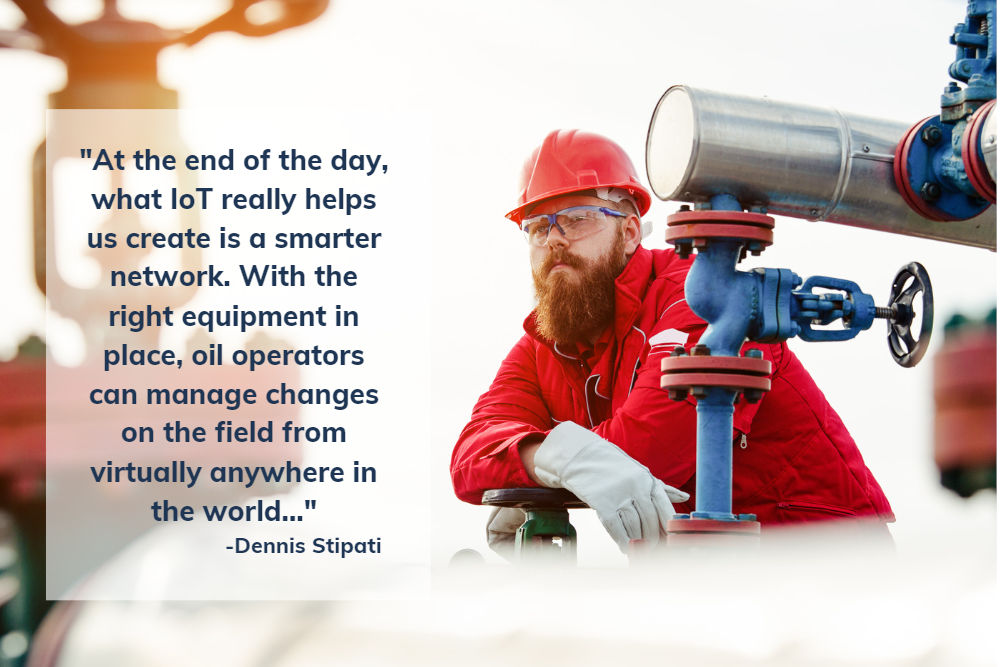
A global expert in telecommunication, Dennis Stipati talks about how today’s energy companies are doing more with the same amount of resources and how FreeWave sees the future for smart oil fields. A true industrial transformation is taking place as we speak. Connected devices delivering data to technicians and managers through the internet – what we all know as the Industrial Internet of Things (IIoT) – are transforming efficiency and productivity for forward-thinking energy companies. Oftentimes, wells are located many miles apart in extreme weather conditions or might even be offshore on an oil rig. Through digitalization, oil and gas leaders are implementing innovative strategies to do more with the same amount of people and resources while increasing overall safety and environmental sustainability. Here, we explore the impact of IIoT in the oil and gas sector with FreeWave’s Senior Director of Strategic Accounts, Dennis Stipati. Q: The Industrial Internet of Things (IIoT) is significantly impacting every industry; what are the top problems IIoT is solving for energy companies?? Dennis: From the operations side of things, being more efficient and increasing revenue is huge. Over the last year or two, there’s been a lot going on in our world. There’s not enough gas, not enough oil, and on top of that, we’re trying to get the oil and gas that we do have to the right places. That’s where IIoT steps in, helping us increase revenue and improve efficiency within operations. For example, if a drilling rig is down for a short period of time, that oil company could lose millions of dollars, potentially. It’s important to be able to remotely control the different sensors on that oil rig so that downtime is decreased and productivity and overall revenue is increased. That’s one benefit. On the other end, IIoT also impacts the overall safety of workers on the field and the surrounding environment. In the past, oil operators weren’t able to get the type of detailed operational information that we have access to today, and this data makes a big difference in reducing safety hazards on the field. With the right equipment in place, we can see when machine parts need to be replaced before their end of life. We can also virtually measure the amount of oil that’s coming through the pipelines and see if there are any leaks or dangerous chemical exposures before a crisis arises. IIoT also helps us control the day-to-day management of our operations from anywhere in the world, which leads to greater sustainability. Say there’s a methane leak of some sort. We can now respond to a situation like this immediately instead of after hundreds of thousands of gallons have been released into the environment. A decrease in environmental hazards means a safer and more sustainable world for all of us. At the end of the day, what IIoT really helps us create is a smarter network. With the right equipment in place, oil operators can manage changes on the field from virtually anywhere in the world, no matter if it’s a change flow, tank pressure, or even the temperature. With a smarter network, these decisions can be made on the edge. Q: How does the use of IIoT in the oil and gas industry impact the everyday person? Dennis: IIoT in oil and gas is important for a number of reasons, but the biggest thing most people pay attention to is gas prices. Whether it’s filling up their car or paying for natural or propane gas, this is an industry that affects all of us. It’s important for oil operators to be as efficient as they can so that they can make a profit and then pass along those cost savings to everyday consumers so that we can continue to do the things that make up our daily lives. Q: What FreeWave products are currently being used in the oil and gas industry? Dennis: It seems like every day, a new app is invented to help make our lives easier. I think FreeWave products function in the same way. Our IIoT solutions, including Zumlink™, ZumEdge®, Fusion™ Bridge radios along with our FreeWave Edge software platform, help our customers operate with greater efficiency and make better decisions on the edge. We currently have our products right on the drilling rigs. A lot of times, these platforms are fairly large, and they’ll have five or six radios on a drilling rig, maybe even more, that are wirelessly interconnected. Our products are also used on the pipeline to measure the flow of the natural gas going through that pipeline as well as the temperature. Some of our radios are used in the terminals to connect a tank to the back office or monitor a fracking pond to make sure there are no leaks. Honestly, I feel like every week, I learn a new way a customer uses our products. You think you know it all, and then someone else comes back and shares a different way they are using our solutions within their remote operation. Q: As you look at the future, and the role of IIoT within it, what excites you the most? Dennis: The common theme I keep seeing in technology is automation. Our population here in North America and even in Europe is decreasing. Recently, I read a report that said there are two jobs available for every person that’s looking for employment. How do we fix that? Automation. The more we use IIoT, the more we can make better decisions without human intervention. Machine learning, autonomy at the edge, and computerized systems, these things all make a big difference in the day-to-day management of our operations. I think we forget just how much more efficient and productive our lives are today because of technology. When I look at my life and think about the evolution of basic TV to streaming services or the transformation of the bag phone to the iPhone, I’m really amazed at how far we’ve come in such a
FreeWave Joins Rural Cloud Initiative
BOULDER, COLO. (November 9, 2022) — FreeWave® Technologies, a leader in industrial wireless technology, today announced a partnership with Trilogy Networks to join its Rural Cloud Initiative (RCI), a unique coalition of over 70 network, technology and applications providers advancing the digital transformation of America’s rural areas. FreeWave joins RCI’s innovation partners in creating the technology and software solutions that will bring the power of cloud computing to local digital clients. Through these partnerships, rural communities will gain access to market-leading edge solutions delivered to them by trusted local partners, enhancing their business operations while improving local economies. RCI will support live networks with true edge compute platforms, where real end-to-end solutions can be delivered for specific use cases within rural industries, precision agriculture, automated food processing, efficient energy production, telemedicine and industrial automation. “We look forward to collaborating with Trilogy and RCI partners in bringing the digital revolution to rural markets,” said Kirk Byles, FreeWave CEO. “This opportunity is directly aligned with our long-standing mission of continuing to innovate for the sustainable future of our rural communities, leveraging our leading capabilities in edge computing and IoT cloud initiative. It is imperative that we figure out how to provide limitless connectivity with wireless, WiFi and affordable satellite solutions – the single-pane of glass visualizations of data and our data broker.” “Rural America, especially the agriculture industry is ripe to undergo a digital transformation, delivering enormous productivity and economic benefit”, said Nancy Shemwell, COO Trilogy Networks. “AgTech made simple – is the key – Trilogy’s FarmGrid™ is the answer. A digital agriculture platform, simplifying connectivity challenges, delivering, and supporting AgTech applications on a single platform allows the grower to see and utilize the data being gathered by a variety of IoT devices. FreeWave and their suite of applications put the power of the data in the grower’s hands – allowing him to augment his decision-making capabilities with truly actionable data.” About FreeWave Technologies: Based in Boulder, Colo., for nearly 30 years, FreeWave Technologies have connected the unconnected with a reliable ecosystem of edge intelligent radios and solutions – manufactured in the United States – to optimize the extreme edge of remote industrial operations. FreeWave has a legacy of solving thousands of customer challenges globally across multiple industries, FreeWave can help transform and future-proof an operation now. Visit freewave.com to get started. About Trilogy Trilogy is an established leader in the emerging Edge Compute ecosystem with the deployment of distributed Cloud installations across the United States. Trilogy recently founded the Rural Cloud Initiative, a coalition of network operators and technology providers committed to promoting and accelerating the digital transformation of rural America. In conjunction with network operators and edge innovation partners, Trilogy is utilizing its LinX™ virtual private network and ConEx service delivery platform to build a unified, distributed cloud capability on a single network fabric to cover 1.5 million square miles. To learn more, please visit www.ruralcloud.com or www.trilogynet.com.
Technology Revealed: Unraveling Data Accessibility for Industrial IoT
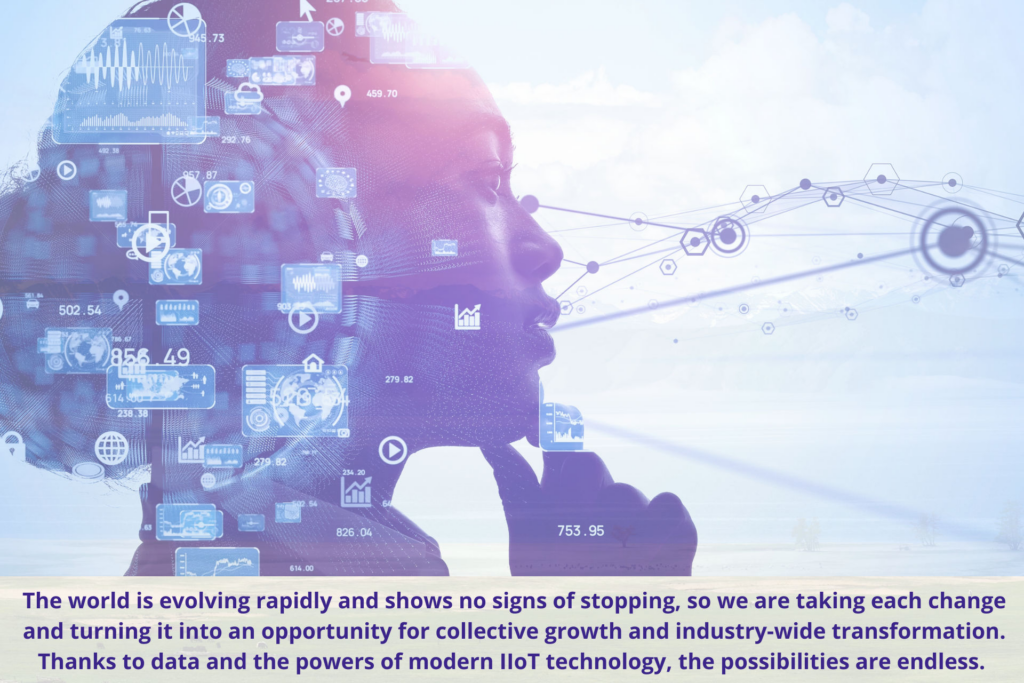
Our world is full of endless possibilities. Thanks to modern technology, we are more digitally connected than ever before. According to Statista, there will be upwards of 30.9 billion connected internet of things (IoT) devices by 2025. From smartwatches and traffic cameras to medical sensors and security systems, the more technology in effect, the more data we are able to collect. If you’ve heard it once, you’ve heard it a hundred times: data is everywhere, and it continues to be an incredible asset for leaders across industrial environments. Today, our widespread access to data allows us to make informed and intelligent decisions based on accurate intel. Something as simple as knowing soil moisture levels or the outside temperatures helps us respond to environmental needs in strategic ways. While data accessibility is undoubtedly a positive thing, it doesn’t mean much if we don’t have the tools needed to act upon those same data insights available to us, and this is where technology makes a tremendous difference, especially for industrial leaders. When we take the revolutionary power of the industrial internet of things (IIoT) and pair it with the wide range of data metrics available, we can intentionally foster better industrial environments across the globe. Our increased access to data, paired with the modern revolution of IIoT technology, allows us to respond to real-world problems with timeliness, precision and contextual intelligence. Together, this dynamic pair fosters safer, faster and more efficient environments for all. The power of time and context When it comes to data accessibility and Industrial IoT, there are many profound revelations of impact, time being just one of them. In industrial environments, timing is everything. It’s the difference between a healthy crop and a wasted harvest for the smart farmer; it’s the difference between an uncontrolled wildfire and a self-contained outbreak for the modern firefighter; it’s even the difference in what could’ve been merely a small oil leak rather than the environmental disaster we now know as the Deepwater Horizon oil spill. Data accessibility provides us with timely information on the surrounding contexts of our environments, and with the right tools, we can respond to this information faster and more efficiently than ever before. Contextual intelligence Next in line to the value of timing, lies the power of contextual data, also known as contextual intelligence. Contextual intelligence is a game-changer for the industrial leader, as it provides a deeper level of understanding and offers an enhanced sense of accuracy for production. Think of any environmental disaster, be it a forest fire, dust storm or even a carbon monoxide leak. While IoT solutions cannot prevent these events from happening, they can provide immediate insight to these occurrences based on contextual analysis. With the right sensors in place, data is retrieved and distributed, making room for timely interception. With the proper insight, operational leaders and manufacturers can observe what’s happening in critical environments and make intelligent decisions based on the contextual data available. Today, IIoT solutions allow us to control external environments virtually anywhere in the world without laborious human intervention. In this modern age, the simple switch of a button or command from a control center can adjust the outputs of remote operations everywhere. We call it a single pane of glass approach. When emergencies arise that need immediate attention, these same IIoT solutions help us respond quickly and efficiently, ultimately maximizing people’s time more effectively. The role of intelligence In addition to time and context, the third component is intelligence. Data takes the guesswork out of problem-solving and invites us to respond with precision-based strategies. Think about smart farmers, for example. With proper insight into the correct data like soil moisture levels, external temperatures, climate measurements and other relevant intel, these farmers can cultivate the most favorable conditions for a quality harvest. Without this information, farming becomes a guessing game that varies from year to year, but when this data is paired with IIoT solutions, agriculture becomes much more about intelligent strategy. Looking ahead, the digitization of farming is quickly becoming a necessary solution. Our world population is rapidly increasing every day, leading us to grow by 2 billion people in the next 30 years alone! A significant increase in people requires a significant need for accelerated food production. In fact, it’s reported that we will need to increase crop yields and harvest more food in the next 30 years than we’ve had to produce for the last 10,000 years combined. Though these statistics are extreme, they don’t have to be alarming because with the right technology in place, society will be up for the task at hand. The interconnected work of data and IIoT takes smart farming to a whole new level, making it less of a gamble and more of a controllable process from seed to harvest. Beyond the world of just smart agriculture, data impacts the role and work of IIoT solutions across every industry, including water and wastewater, electricity, oil and gas, transportation and traffic and many others. Our ability to access data empowers us to leverage IIoT technology most intelligently; it’s the “work smarter, not harder” mindset at its finest. Technological pioneers At FreeWave Technologies, we are passionate about creating real-world solutions for everyday needs across industries. In a world that is changing with rapid succession, connectivity is critically important for industry leaders, remote operations and the basic good of society. We need tools and products that help us act on data quickly and precisely, and our line of products is helping our customers do just that. FreeWave products take the complexity of industrial IoT applications and simplify them for the user, creating a digitization strategy that connects data with life. Our easy-to-use applications allow controllers to respond to their deployed assets from one place with timeliness, intelligence and precision. At FreeWave, we are pioneering a new way forward, promoting connection, safety and innovation along the way. The world is evolving rapidly and shows no signs of stopping, so we are taking each
The Unlikely Marriage of Sustainability and IIoT
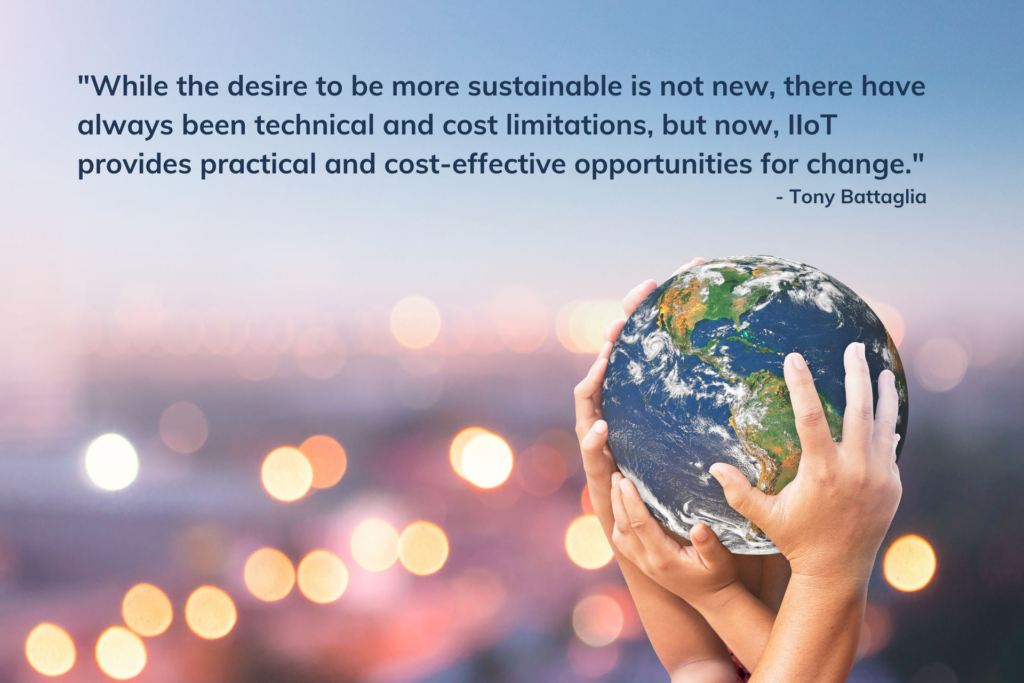
When I think about technology’s impact on sustainability, I think about home. I live in California, and earlier this year there was a fire in my area which, unfortunately, destroyed a lot of houses and affected many families. Luckily, because my city deployed industrial internet of things (IIoT) solutions for fire protection services, they were able to detect this fire early on and prevent further damage in the area. In this scenario, IIoT solutions provided timely insights which allowed the appropriate resources to respond faster, creating a better and safer future for my community. The unlikely pair Sustainability is a widespread conversation these days, and for good reason – a more environmentally conscious world equals better quality of life for us all. As such, electric cars are on the rise, paper straws are everywhere and many companies are doing their part to minimize their carbon footprint. As a collective, we are making great strides in our attempt to create more eco-friendly communities. Amidst our best efforts, however, many may not realize the positive and profound role modern technology, specifically IIoT, can have on our journey towards a greener society. This may come as a surprise, but now more than ever, IIoT is playing a key role in realizing our sustainability goals. Real-world change Today, IIoT technology is completely enhancing our approach to transformative environmental practices by providing the power of response. By implementing IIoT into our data, we can do much more than just monitor data; we can actually respond to data by pulling trends, sending out alerts, leveraging artificial intelligence and so much more. IIoT allows us to take data-driven action, and this is ultimately having a significant impact on the environment and entire industries across the globe. Industry-wide impact In 2015, The United Nations Member States all adopted the 2030 Agenda for Sustainable Development. This global partnership calls countries into action to create a stronger planet by implementing eco-friendly strategic practices to achieve 17 different Sustainable Development Goals (SDGs). Technology plays a significant role in realizing these SDGs. In fact, there are a variety of industries becoming more sustainable because of IIoT. Let’s look at energy, for example. Recently, the energy space began implementing environmental and social governance (ESG) criteria. Now, different organizations can receive access to various federal funds depending on their ability to meet ESG standards. Without the use of IIoT practices, procedures and functions, these organizations could not make the improvements needed to contribute to their environmental goals. With the use of IIoT, these same companies can effectively monitor and manage environmental assets through automated procedures that contribute to more efficient industries and remote work environments across the board. Ultimately, IIoT technology offers the insight and practical solutions needed for these companies to create positive structural changes. The benefits don’t stop there. We’ve all heard or read that our water supply is endangered, and this is not just a California issue, like many assume; it’s a widespread problem that needs immediate attention. The rapid rate of water decrease is not just a byproduct of human consumption, it is also a direct result of everyday processes, industrialization and the ever-changing climate. Today, IIoT products are providing simple solutions to monitor timely data metrics like rainfall rate and water consumption. These solutions respond to water shortages and water waste in innovative ways. Through IIoT, we now have the ability to adjust and adapt our behaviors based on data visualizations, and throughout the process, greater sustainability is achieved worldwide. The IIoT difference on finite resources With sustainability, the goal is really to manage the lifespan of an existing asset, be it drinking water, livestock, oil and gas, the list goes on, and with IIoT technology, we can better control our ability to manage these assets. While the desire to be more sustainable is not new, there have always been technical and cost limitations, but now, IIoT provides practical and cost-effective opportunities for change. At FreeWave Technologies, we’re committed to improving life’s essentials through Industrial IoT solutions. Our full line of connected IIoT network solutions bring most needed data to operations teams wherever they are and our ready-to-deploy solutions play a significant role in environmental monitoring ultimately leading to safer and more sustainable communities. When it comes to Environmental IoT™ we are spearheading a new way forward, offering solution-based products that empower industrial leaders to manage their assets simply and intentionally. Our single pane of glass dashboard creates a singular view for our customer, allowing them to track, control and respond to timely data metrics in one place instead of multiple dashboards across applications. Products that solve problems are important, and that’s exactly what we’re providing at FreeWave. We’re shifting the culture of sustainability from altruism to action, and it’s making a substantial difference. At the end of the day, I care about the world that I’m leaving for the next generation. Every day I think about my two children and the world they’ll grow up in; I want to do my best to create a place where they can thrive, and I’m excited to be a part of an organization that is achieving just that.
Technology’s Impact on Air Quality Control Monitoring
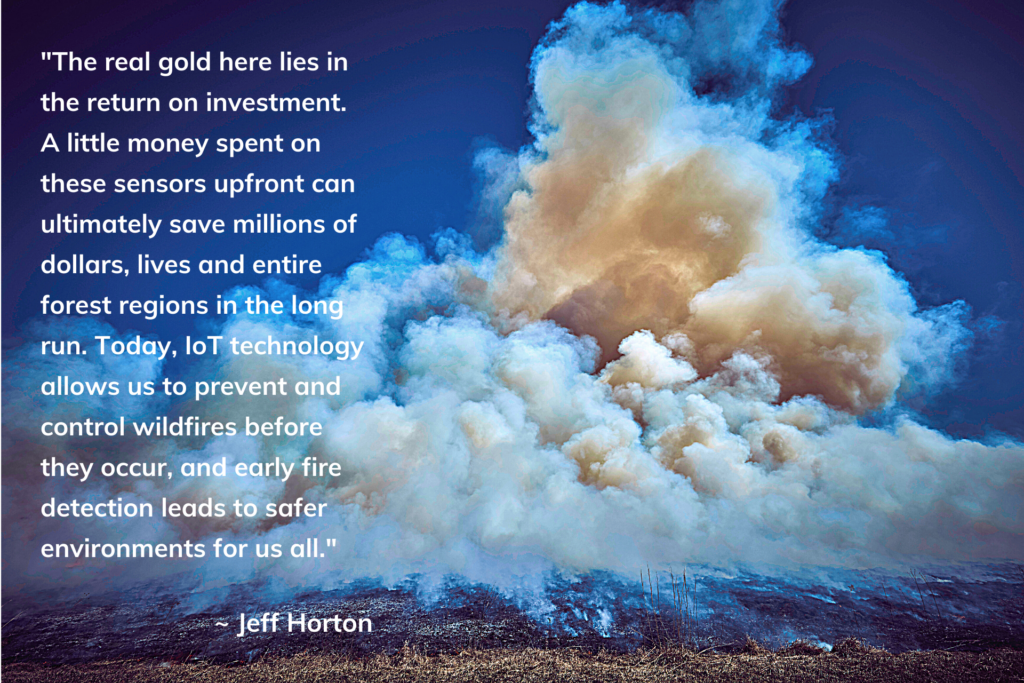
At this very moment, wildfire season is currently underway in North America, and since the start of this year alone, more than 27,000 wildfires have consumed nearly two million acres according to the National Interagency Fire Center (www.nifc.gov). Though many people hear the word “wildfire” and immediately picture a forest in California, the reality is these natural disasters are prevalent across the country. Wildfires are everywhere The Verge, a technology news website, announced recently that roughly 56% of homeowners in the United States face some sort of wildfire risk in the upcoming decades. Bottom line: wildfires are becoming more prevalent and costly every day, and these fires are affecting more than half the population and significantly changing our quality of life. Just a few decades ago, we didn’t have the technology to prevent or predict changes in the surrounding air quality, but now we do, and through it, we can create a better world. Today’s technological advancements allow us to be proactive rather than reactive when it comes to our overall health and safety. By leveraging sensor technology, we have a better chance of predicting and preventing significant changes in the environment, like a drastic shift in air quality before a wildfire begins. This insight allows us to make better decisions based on intentional insights, and our increased access to data provides us with the right information to better control our surrounding environments. Technology is powerful, and this power can and should be used to our advantage. One of my favorite ways to witness the power of technology transforming real-world issues is by exploring the ways sensor technology has a tremendous impact on air quality control monitoring. Today, internet of things (IoT) technology and satellite are the best tools for early detection and prevention of wildfires. Our approach to air quality control Believe it or not, air quality has as much impact on the world as the daily temperature. With climate change causing drastic shifts in the environment, it’s important that we pay close attention to the quality of the air we breathe, as it affects our overall quality of life. As you know, trees play a critical role in our ecosystem, so we must be very intentional and proactive about protecting the forests around us. This is where sensor technology makes a big difference. With a small machine, we can now track and predict changes in the environment and our surrounding air quality, which ultimately helps us control, prevent and predict conditions that lead to wildfires. At FreeWave, we provide autonomous sensors that are strategically placed in remote locations to track and record relevant data metrics such as temperature, humidity, wind, direction and particulate matter. These readings help industry experts know what’s in the air and how the air is changing. Once this data is collected and transmitted to the cloud, we are then able to analyze it and provide alert and proactive responses where needed. We have created a single pane of glass approach, where anyone with access can log into a portal and see in real-time what is happening in the areas surrounding their deployed sensors. The interesting thing about our sensors is that they are fully powered by solar energy, and satellite signals transmit the recorded data. We are basically offering a “buy, install and forget” resource that makes life significantly easier for industry and environmental experts. There is a ton of value here. Not only are we taking an in-depth look at what’s going on in the environment through air quality control monitoring, but we are also taking that information and transforming it into action. The real gold here lies in the return on investment. A little money spent on these sensors upfront can ultimately save millions of dollars, lives and entire forest regions in the long run. Today, IoT technology allows us to prevent and control wildfires before they occur, and early fire detection leads to safer environments for us all. A unique human aid We are making life simpler and safer for all by using technology to do what humans can’t. Back in the day, people had to sit in an operation tower for hours, looking out to catch any major changes in the environment. Today, there is a major shortage of people willing to do this kind of work, and can you blame them? As humans, we can only be in one place at a time doing one thing at a time, but with technology, this is not the case. With simple sensors, we can now monitor and control a lot more environments at a much more affordable rate. All this to say, the goal here is not to replace humans with technology as some might think; what we are really doing is enhancing human ability through the power of technology. I’ve worked in technology for over 30 years, and every day I witness its evolution. I know it’s hard to imagine a world without cell phones, but I can still clearly recall the days when cell phones took up the entire trunk of a car, and now look at the world, most of us carry the same ubiquitous smartphone in our pockets. Technology is amazing, and we have the opportunity to use it to our advantage. At FreeWave, we are taking the capabilities of mobility – LTE, 4G, Satellite, Wi-Fi, Bluetooth, 900 MHz– and marrying them with sensors. The data we gain from these sensors is saving us time, money and resources. At the end of the day, we’re taking away the need to “overthink” industry issues, like how to better prevent forest fires, and instead are replacing our questions with data-informed predictions and timely proactive responses. Every day, we strive to provide industry leaders with the tools and technology needed to spearhead faster and safer environments for us all. This is certainly not a boring business, and I thoroughly enjoy working for a company that is using technology to have an impact on the things that matter most.
Got Data? Now what?
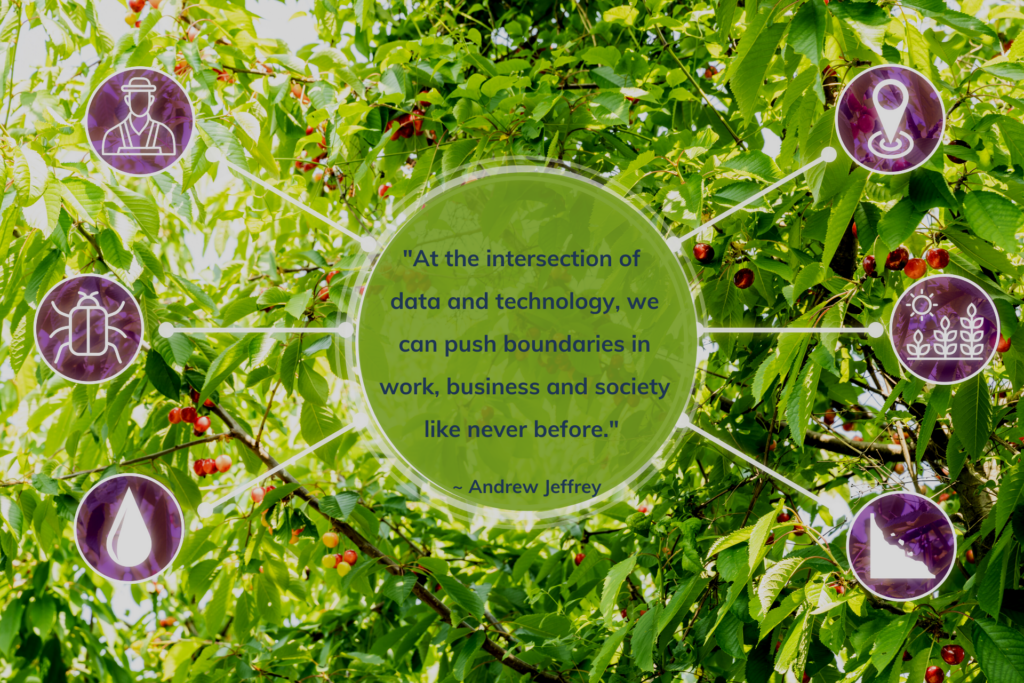
It’s hard to imagine a world without the daily convenience of modern technology. Just yesterday, I joked with my kids about the world before the internet – a time when we actually had to go to the library to look up unknown information. I can still remember the early days of my college career back in the late 90s, the internet had just come out, and we were all getting used to this new phenomenon called a “search engine.” Life has drastically changed over the last 25 years. Now, nearly all the information we want and need is at our fingertips. Today, we have more access to data than most people know how to handle. Data is all around us, collected through the day-to-day actions and reactions of our lives. When we take the time to intentionally analyze, interpret and distribute the data metrics available to us, we can make smarter and more efficient decisions. There is so much to explore, and while our increased access to data is pretty interesting, the reality is that the combination of data and modern technology can change the world. Like many things, though, there are two sides. Sure, industrial companies can capture huge amounts of data, but it also raises the question: now what? How do you put all that data to work? Breaking barriers and pushing boundaries At the intersection of data and technology, we can push boundaries in work, business and society like never before. Data insights allow us to be more precise and accurate in our day-to-day work, which allows us to be more effective and efficient. The operational benefits here are endless, including improved quality control, reduced energy consumption, enhanced safety and increased operational consistency. Just take a look at the food industry, for example. Many field workers in smart agriculture rely heavily on data insights to control, predict and create the best environments for quality crops and harvest. The more accurate their predictions, the better their harvest, and the better their harvest, the faster we receive our food through the supply chain. Today, internet of things (IoT) technology can connect remote and mobile assets, like a tractor, for instant data access, making it easier for farmers to be more efficient and effective in their work. It’s really amazing when you think about it. Data is transforming how we operate in this world, creating better environments for us all. The FreeWave impact At FreeWave, we are constantly pushing the boundaries of technology to create faster, smarter and more efficient work environments. I’ve been a part of the FreeWave team since 2019, and I am constantly amazed at the ways our technology provides innovative solutions for real-world issues. Our products enable our customers to improve their work processes, and through our single pane of glass approach, we offer a simplified experience for businesses and industry leaders to receive automated technology that transforms data metrics into real-time execution. One of my favorite use cases to discuss is FreeWave customer that uses drone technology to deliver food and other valuable resources to far-reaching areas across the globe. With FreeWave products, they can run a smarter and more efficient operation. Their robotics delivery system is combating many of the complex access challenges the world faces on a daily basis. Our IoT technology is helping them solve complex issues with simplified tech solutions, and simple solutions create more time, energy and space to focus on what matters most: people. If you need a product to help you bridge the gap between technology and data, FreeWave is your solution. We are enablement partners, helping every one of our customers accomplish their complex goals. It’s inspiring to work with brands and businesses striving to create a difference in real-world issues. Our technology plays an intricate role in sustaining work environments and supporting entire industries around the globe. Data makes the difference At the end of the day, data is more than mere statistics; data is the key to our efficiency, productivity and safety. Data makes the difference in energy consumption reduction. Data makes the difference in the overall quality and safety of our daily environments. Data makes the difference in everything. Every day we have the opportunity to use data to our advantage, and at FreeWave, we are helping industrial innovators do just that. As technology continues to evolve, we will continue to provide top of the line IoT solutions that transform data into actionable insights and execution so you can not only access a treasure trove of data, but also know exactly how to answer the age-old question: now what?
Data is everywhere, even on Mount Everest: Sensor-to-cloud and extreme environments
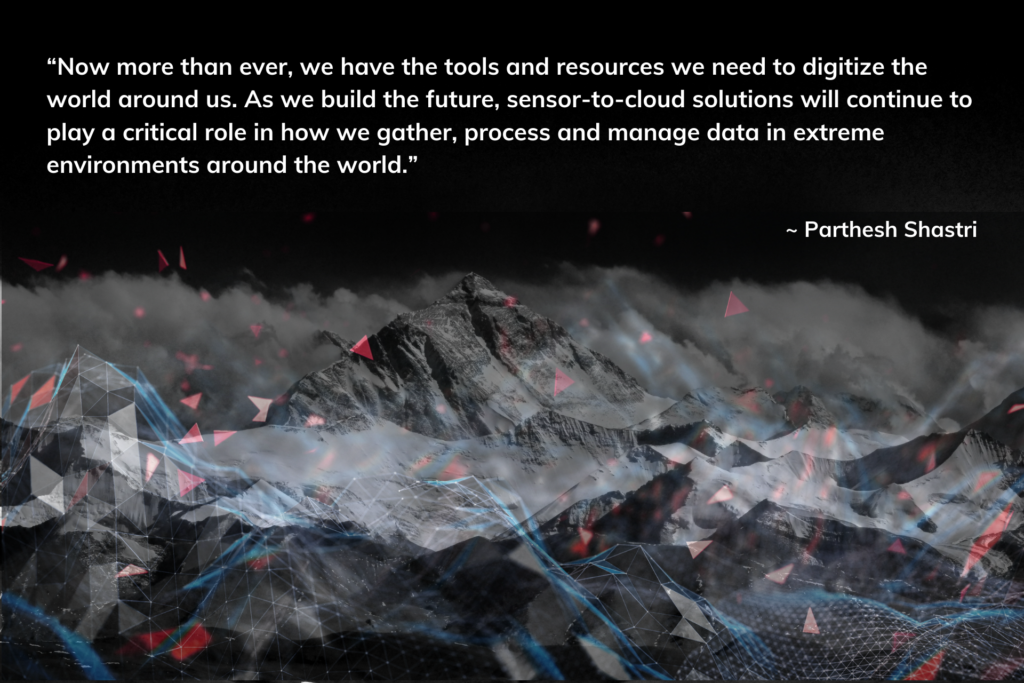
Technology – from Mount Everest to the farm It’s amazing what technology can do when paired with human will. Just a few years ago, a team of scientists made history as they trekked up Mount Everest with the goal of running environmental studies. With backpacks full of sensors (which included FreeWave technology), these men pushed boundaries to create a new normal. When we intentionally use modern technology to our advantage, we can create better, safer and more productive environments within every industry. Today, the same technology used on Mount Everest is now powering multiple earth science programs transmitting sensor data from remote environments to earth scientists, climatologists and meteorologists through cloud servers. This is just one example of many where sensor-to-cloud solutions have transformed our ability to interact with extreme environments in the modern world. A deeper look at extreme environments Typically, when someone thinks of an extreme environment, they imagine harsh, rugged terrain in a far-off remote location; however extreme environments aren’t limited by this definition. Take a large farm, for example, with a multitude of deployed assets and equipment across hundreds of acres. Traditionally, an operation like this requires an employee to physically check on the farm equipment multiple times a week, manually turning valves on and off, in addition to monitoring and controlling the overall farm environment. These day-to-day tasks are not only time-consuming but physically draining. In this case, the operational output required on the farm makes it an operationally extreme environment, and extreme environments are just one space where sensor-to-cloud solutions shine. Sensor-to-cloud in the real world Today, sensor-to-cloud systems utilize deployed sensors to collect and transmit data from remote locations. These sensors send the gathered information back to cloud servers for further research and analysis, enabling entire teams to utilize their limited time and resources more effectively. With sensor-to-cloud systems, we eliminate the often-laborious mechanics of middlemen procedures so that industry leaders can focus on what matters most. Let’s revisit that farming example. With sensor-to-cloud technology, farmers can automate the repetitive tasks of their operations. Something as simple as discrete soil sensors further allow farmers to virtually monitor their crop health, creating more time and space to focus on other high-value tasks. This gives them time, often an invaluable asset, to do what’s needed. In a sense, we can improve the productivity of an operation with an automated suite of sensor systems. Imagine the difference a network of sensors can make. The FreeWave difference For several years now, FreeWave products have been a leading resource solution for extreme environments. Our sensors were a part of the great Mount Everest expedition, and today, we have deployed sensors in many areas, including pipelines in Alaska, ice shelves in Antarctica, smart farms across the country and many other locations – rugged and traditional. We are providing the groundbreaking technology needed to monitor data in extreme environments so that our partners and customers can make the best, informed decisions for their operations. As the Chief Technology and Product Officer at FreeWave, I am constantly amazed at the impact our products have on the world. We are working with some of the major brands of our time, helping them solve massive problems affecting society at large. Our technology solutions serve entire industries, like oil and gas, agriculture, transportation and traffic, as well as many others that contribute to the well-being of the globe. It is great to be a part of a company where we can say our products are a part of the solution for life’s essentials. Every day, we help industry leaders identify their pain points and provide them with a single pane of glass product solution that helps them see the data wherever they are without the drain of additional resources. Our rich portfolio of radios, gateways, cloud software and analytics allows us to stitch together a range of packaged ready to use applications that solve our customer’s problems through simple, turn-key solutions. Sensor-to-cloud in the future Data is everywhere, and now more than ever, we have the tools and resources we need to digitize the world around us. As we build the future, sensor-to-cloud solutions will continue to play a critical role in gathering, processing and managing data in extreme environments around the globe. As I look at the world before us, I see endless opportunities to continue to leverage technology and data to build a better and more informed life.



